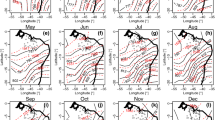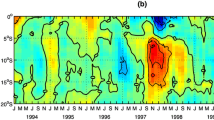Abstract
A case study of warm air advection over the Arctic marginalsea-ice zone is presented, based on aircraft observations with direct flux measurements carriedout in early spring, 1998. A shallow atmospheric boundary layer (ABL) was observed, which wasgradually cooling with distance downwind of the ice edge. This process was mainly connected with astrong stable stratification and downward turbulent heat fluxes of about 10–20 W m-2, but wasalso due to radiative cooling. Two mesoscale models, one hydrostatic and the other non-hydrostatic,having different turbulence closures, were applied. Despite these fundamental differences betweenthe models, the results of both agreed well with the observed data. Various closure assumptions had amore crucial influence on the results than the differences between the models.Such an assumption was, for example,the parameterization of the surface roughness for momentum (z0) and heat (zT). This stronglyaffected the wind and temperature fields not only close to the surface but also within and abovethe temperature inversion layer. The best results were achieved using a formulation for z0 that took intoaccount the form drag effect of sea-ice ridges together withzT = 0.1z0. The stability within theelevated inversion strongly depended on the minimum eddy diffusivity Kmin. A simple ad hocparameterization seems applicable, where Kmin is calculated as 0.005 timesthe neutral eddy diffusivity. Although the longwave radiative cooling was largest within the ABL, theapplication of a radiation scheme was less important there than above the ABL. This was related to theinteraction of the turbulent and radiative fluxes. To reproduce the strong inversion, it wasnecessary to use vertical and horizontal resolutions higher than those applied in most regional andlarge-scale atmospheric models.
Similar content being viewed by others
References
Abdella, K. and McFarlane, N.: 1997, ‘A New Second-Order Turbulence Closure Scheme for the Planetary Boundary Layer’, J. Atmos. Sci. 54, 1850–1867.
Alestalo, M. and Savijärvi, H.: 1985, ‘Mesoscale Circulations in a Hydrostatic Model: Coastal Convergence and Orographic Lifting’, Tellus 37A, 156–162.
Andreas, E. L.: 1987, ‘A Theory for the Scalar Roughness and the Scalar Transfer Coefficients over Snow and Sea-Ice’, Boundary-Layer Meteorol. 38, 159–184.
Andreas, E. L., Claffey, K. J., and Makshtas, A. P.: 2000, ‘Low-Level Atmospheric Jets and Inversions over the Western Weddell Sea’, Boundary-Layer Meteorol. 97, 459–486.
Andreas, E. L., Tucker III, W. B., and Ackley, S. F.: 1984, ‘Atmospheric Boundary-Layer Modification, Drag Coefficient, and Surface Heat Flux in the Antarctic Marginal Ice Zone’, J. Geophys. Res. 89, 649–661.
Arya, S. P. S.: 1975, ‘A Drag-Partitioning Theory for Determining the Large-Scale Roughness Parameter and Wind Stress on Arctic Pack Ice’, J. Geophys. Res. 80, 3447–3454.
Bennett Jr., T. J. and Hunkins, K.: 1986, ‘Atmospheric Boundary Layer Modification in the Marginal Ice Zone’, J. Geophys. Res. 91, 13033–13044.
Bigg, E. K., Leck, C., and Nilsson, E. D.: 1996, ‘Sudden Changes in Arctic Atmospheric Aerosol Concentrations during Summer and Autumn’, Tellus, Ser. B 48B, 254–271.
Birnbaum, G.: 1998, ‘Numerical Modelling of the Interaction between Atmosphere and Sea-Ice in the Arctic Marginal Ice Zone’, Rep. Polar Res. 268, 1–160.
Birnbaum G. and C. Lüpkes: 2002, ‘A New Parameterization of Surface Drag in theMarginal Sea-Ice Zone’, Tellus, Ser. A 54, 107–123.
Brown, A. R.: 1996, ‘Evaluation of Parameterization Schemes for the Convective Boundary Layer Using Large-Eddy Simulation Results’, Boundary-Layer Meteorol. 81, 167–200.
Brümmer, B. and Thiemann, S.: 2002, ‘The Atmospheric Boundary Layer in an Arctic Wintertime On-Ice Air Flow’, Boundary-Layer Meteorol. 104, 53–72.
Brümmer, B., Busack, B., and Hoeber, H.: 1994, ‘Boundary-Layer Observations over Water and Arctic Sea-Ice during On-Ice Air Flow’, Boundary-Layer Meteorol. 68, 75–108.
Cheng, B. and Vihma, T.: 2002, ‘Modelling of Sea-Ice Thermodynamics during Warm-Air Advection’, J. Glaciol., in press.
DKRZ: 1994, The ECHAM 3 Atmospheric General Circulation Model, Technical Report 6, Deutsches Klimarechenzentrum, Hamburg, Germany.
Dyer, A. J.: 1974, ‘A Review of Flux-Profile Relationship’, Boundary-Layer Meteorol. 7, 363–372.
Fairall, C. W. and Markson, R.: 1987, ‘Mesoscale Variations in Surface Stress, Heat Fluxes, and Drag Coefficient in the Marginal Ice Zone during the 1983 Marginal Ice Zone Experiment’, J. Geophys. Res. 92, 6921–6932.
Garbrecht, T., Lüpkes, C., Hartmann, J., and Wolff, M.: 2002, ‘Atmospheric Drag Coefficients over Sea-Ice-Validation of a Parameterization Concept’, Tellus A 54, 205–219.
Glendening, J. W.: 1994, ‘Dependence of Boundary Layer Structure near an Ice-Edge Coastal Front Upon Geostrophic Wind Direction’, J. Geophys. Res. 99, 5569–5581.
Guest, P. S., Glendening, J. W., and Davidson, K. L.: 1995, ‘An Observational and Numerical Study of Wind Stress Variations within Marginal Ice Zones’, J. Geophys. Res. 100, 10,887-10,904.
Handorf, D., Foken, T., and Kottmeier, C.: 1999, ‘The Stable Atmospheric Boundary Layer over an Antarctic Ice-Sheet’, Boundary-Layer Meteorol. 91, 165–189.
Hartmann, J., Albers, F., Argentini, S., Bochert, A., Bonafe, U., Cohrs, W., Conidi, A., Freese, D., Georgiadis, T., Ippoliti, A., Kaleschke, L., Lüpkes, C., Maixner, U., Mastrantonio, G., Ravegnani, F., Reuter, A., Trivellone, G., and Viola, A.: 1999, ‘Arctic Radiation and Turbulence Interaction Study (ARTIST)’, Rep. Polar Res., Vol. 305, Alfred-Wegener-Institute for Polar andMarine Res., Bremerhaven, Germany, 81 pp.
Hartmann, J., Kottmeier, C., and Raasch, S.: 1997, ‘Roll Vortices and Boundary-Layer Development during a Cold Air Outbreak’, Boundary-Layer Meteorol. 84, 45–65.
Hartmann, J., Kottmeier, C., Wamser, C., and Augstein, E.: 1994, ‘Aircraft Measured Atmospheric Momentum, Heat and Radiation Fluxes over Arctic Sea-Ice’, in O. M. Johannessen, R. Muench, and J. E. Overland (eds.), The Polar Oceans and their Role in Shaping the Global Environment, Geophys. Monogr. Ser., Vol. 85, AGU, Washington, D.C., pp. 443–454.
Jordan, R. E., Andreas, E. L., and Makshtas, A. P.: 1999, ‘Heat Budget of Snow-Covered Sea Ice at North Pole 4’, J. Geophys. Res. 104, 7785–7806.
Kaleschke, L., Lüpkes, C., Vihma, T., Haarpaitner, J., Bochert, A., Hartmann, J., and Heygster, G.: 2001, ‘Validation of a High Resolved SSM/I Sea Ice Algorithm Using Airborne and ERS-2 SAR Data and Atmospheric Models’, Can. J. Remote Sens. 27, 526–536.
Källen, E. (ed.): 1996, HIRLAM Documentation Manual, Swedish Meteorological and Hydrological Institute, Norrköping, Sweden.
Kantha, L. H. and Mellor, G. L.: 1989, ‘A Numerical Model of the Atmospheric Boundary Layer over a Marginal Ice Zone’, J. Geophys. Res. 94, 4959–4970.
Kottmeier, C.: 1993, User Handbook Polar Aircraft, Alfred Wegener Institute for Polar and Marine Research, Bremerhaven, Germany, 46 pp.
Launiainen, J., Cheng, B., Uotila, J., and Vihma, T.: 2001, ‘Turbulent Surface Fluxes and Air-Ice Coupling in the Baltic Air-Sea-Ice Study (BASIS)’, Ann. Glaciol. 33, 237–242.
Lüpkes, C. and Schlünzen, K. H.: 1996, ‘Modelling the Arctic Convective Boundary-Layer with Different Turbulence Parameterizations’, Boundary-Layer Meteorol. 79, 107–130.
Mahrt, L., Sun, J., Blumen, W., Delany, T., and Oncley, S.: 1998, ‘Nocturnal Boundary-Layer Regimes’, Boundary-Layer Meteorol. 88, 255–278.
Mellor, G. L. and Yamada, T.: 1974, ‘A Hierarchy of Turbulence Closure Models for Planetary Boundary Layers’, J. Atmos. Sci. 31, 1791–1806.
Olsson, P. Q. and Harrington, J. Y.: 2000, ‘Dynamics and Energetics of the Cloudy Boundary Layer in Simulations of Off-Ice Flow in the Marginal Ice Zone’, J. Geophys. Res. 105, 11889–11899.
Overland, J. E. and Turet, P.: 1994, ‘Variability of the Atmospheric Energy Flux across 70° N Computed from the GFDL Data Set’, in O. M. Johannessen, R. Muench, and J. E. Overland (eds.), The Polar Oceans and their Role in Shaping the Global Environment, Geophys. Monogr. Ser. Vol. 85, AGU, Washington, D.C., pp. 313–325.
Savijärvi, H.: 1991, ‘The United States Great Plains Diurnal ABL Variation and the Nocturnal Low-Level Jet’, Mon. Wea. Rev. 119, 833–840.
Savijärvi, H.: 1997, ‘Diurnal Winds around Lake Tanganyika’, Quart. J. Roy. Meteorol. Soc. 123, 901–918.
Savijärvi, H. and Kauhanen, J.: 2001, ‘High Resolution Numerical Simulations of Temporal and Vertical Variability in the Stable Wintertime Boreal Boundary Layer: A Case Study’, Theor. Appl. Climatol. 70, 97–103.
Savijärvi, H. and Räisänen, P.: 1998, ‘Longwave Optical Properties ofWater Clouds and Rain’, Tellus 50A, 1–11.
Savijärvi, H., Arola, A., and Räisänen, P.: 1997, ‘Shortwave Optical Properties of Precipitating Waterclouds’, Quart. J. Roy. Meteorol. Soc. 123, 883–899.
Schlünzen, K. H.: 1988, ‘Das mesoskalige Transport-und Strömungsmodell METRAS-Grundlagen, Validierung, Anwendung’, Hamburger Geophysikalische Einzelschriften A88, 1–139 (in German).
Schlünzen, K. H.: 1990, ‘Numerical Studies on the Inland Penetration of Sea Breeze Fronts at a Coastline with Tidally Flooded Mudflats’, Beitr. Phys. Atm. 63, 243–256.
Therry, G. and Lacarrere, P.: 1983, ‘Improving the Eddy Kinetic Energy Model for Planetary Boundary Layer Description’, Boundary-Layer Meteorol. 25, 63–88.
Vihma, T. and Brümmer, B.: 2002, ‘Observations and Modelling of On-Ice and Off-Ice Air Flows over the Northern Baltic Sea’, Boundary-Layer Meteorol. 103, 1–27.
Vihma, T. and Kottmeier, C.: 2000, ‘A Modelling Approach for Optimizing Flight Tatterns in Airborne Meteorological Measurements’, Boundary-Layer Meteorol. 95, 211–230.
Wang, S., Wang, Q., Jordan, R. E., and Persson, P. O. G.: 2001, ‘Interactions among Longwave Radiation of Clouds, Turbulence, and Snow Surface Temperature in the Arctic: A Model Sensitivity Study’, J. Geophys. Res. 106, 15323–15333.
Zilitinkevich, S. and Mironov, D. V.: 1996, ‘A Multi-Limit Formulation for the Equilibrium Depth of a Stably Stratified Boundary Layer’, Boundary-Layer Meteorol. 81, 325–351.
Author information
Authors and Affiliations
Rights and permissions
About this article
Cite this article
Vihma, T., Hartmann, J. & Lüpkes, C. A Case Study Of An On-Ice Air Flow Over The Arctic Marginal Sea-Ice Zone. Boundary-Layer Meteorology 107, 189–217 (2003). https://doi.org/10.1023/A:1021599601948
Issue Date:
DOI: https://doi.org/10.1023/A:1021599601948




